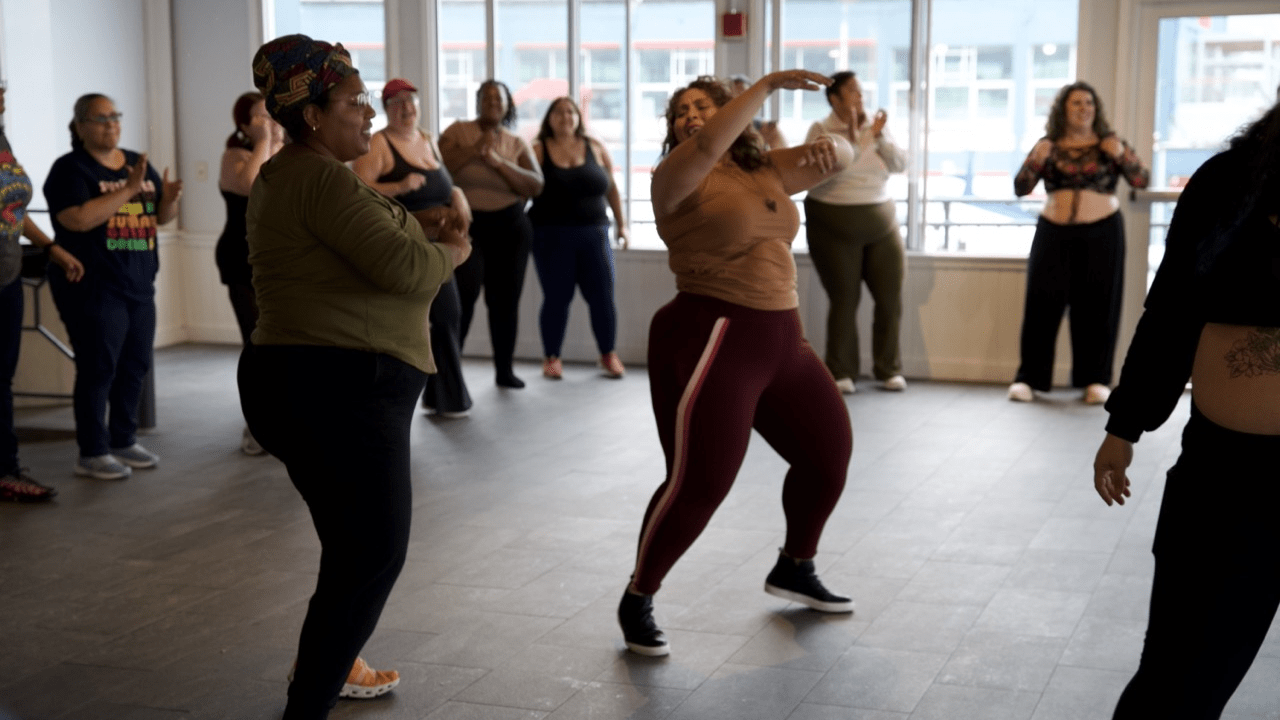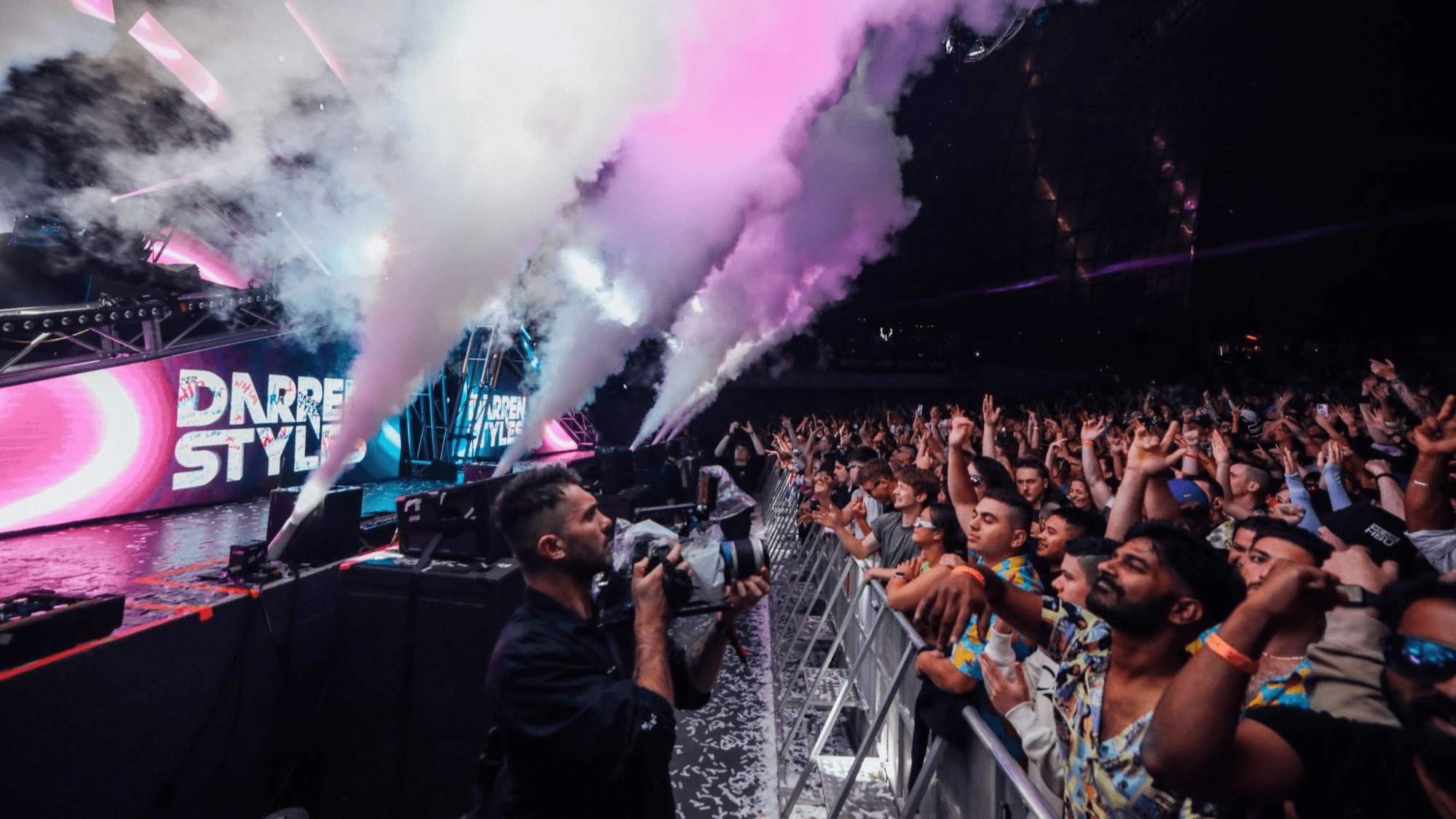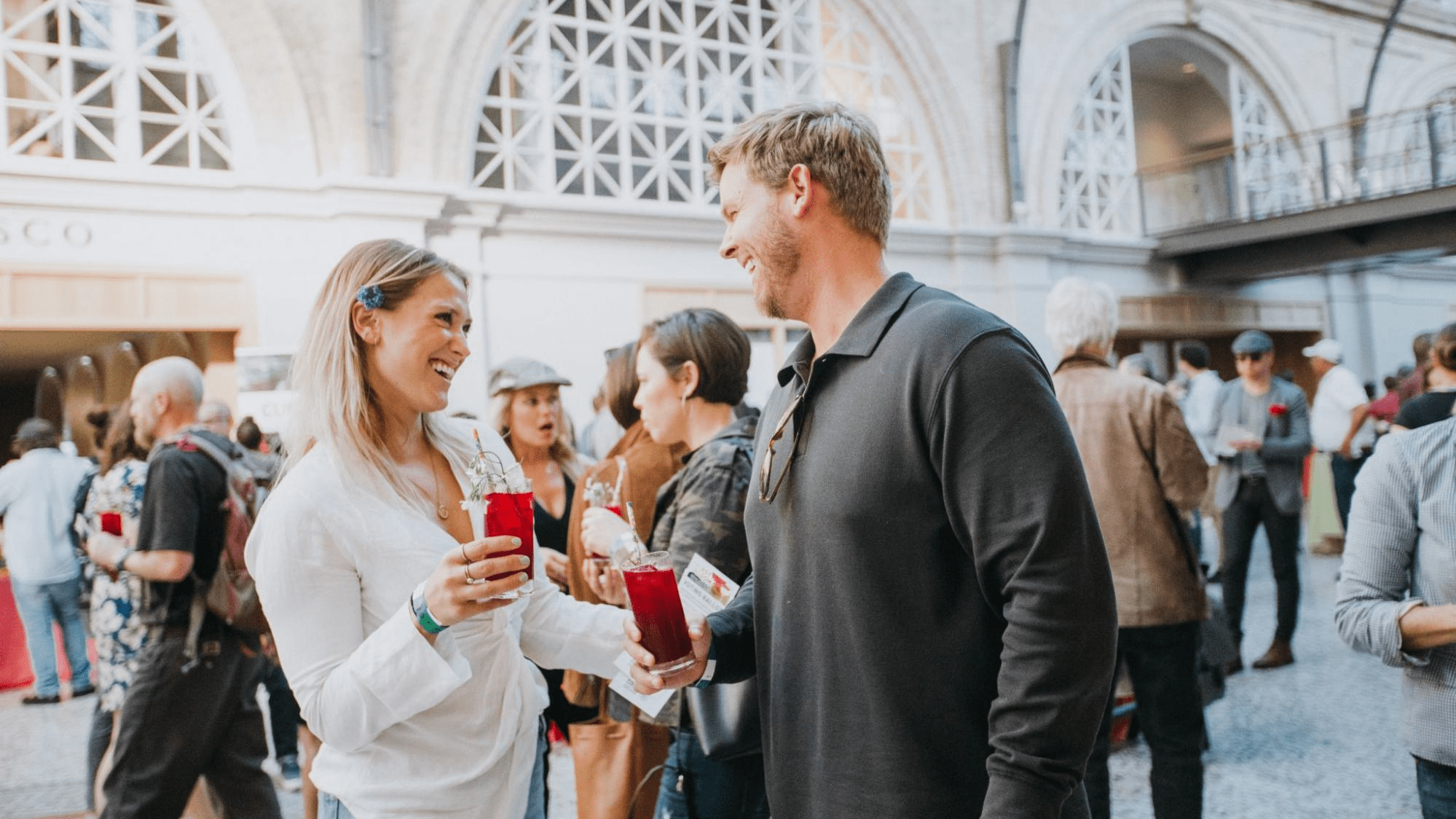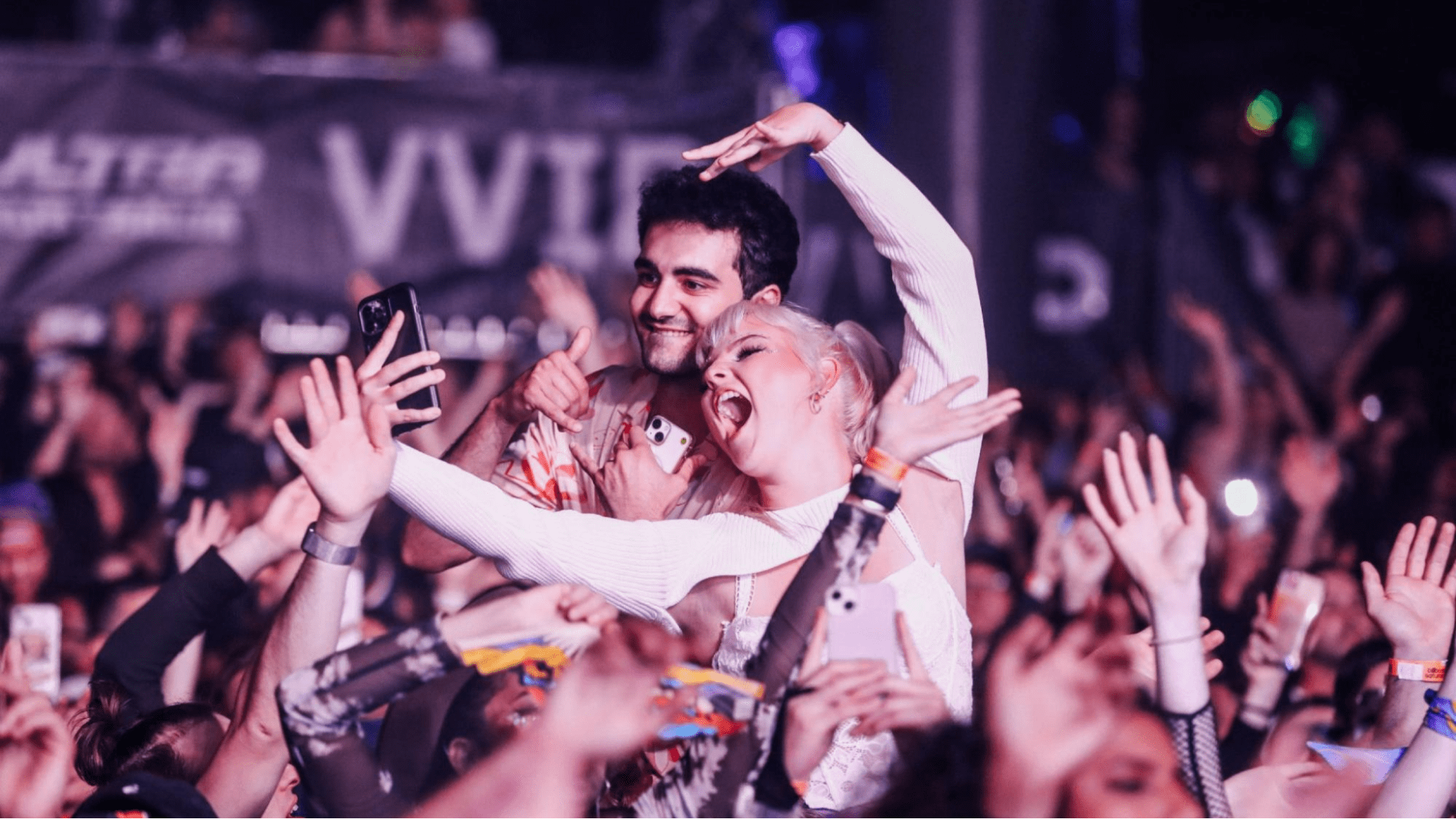Event production is where all the moving parts finally come together — and where things can go sideways if you’re not prepared.
From managing technical setups to navigating the unexpected challenges on-site, the stakes are high and the pressure is real. No matter how much experience you have, there’s always something new to tackle: a last-minute change, a sudden equipment failure, or an issue with the venue itself.
At Eventbrite, we’ve had the opportunity to work alongside countless event organisers, learning what works — and what doesn’t — when it comes to ensuring your event runs smoothly. Whether you’re managing a venue yourself or coordinating with outside spaces, understanding the ins and outs of event production is key to seamless execution.
In this guide, we’ll walk you through the core elements of event production, highlighting common obstacles and offering practical strategies for overcoming them. With a detailed production timeline and expert tips, we’ll help you stay on track and tackle the complexities of your next event with confidence.
Event production vs event planning vs event management
Event production, event planning, and event management are each essential when it comes to pulling off a successful event. While they have distinct focuses, they often overlap in practice. For example, one person might wear all three hats for smaller teams or events.
Still, understanding what each role entails can help you build the right support and tools to create unforgettable events. Let’s break them down to see what each one brings to the table.

Event planning: This is where ideas take shape, budgets are crafted, and marketing is planned. It’s your game plan. Want to make it effortless? With Eventbrite’s event management platform, you can confidently plan events, reach a wider audience, and build and engage your community.
Event management: Event management involves ensuring the event plan doesn’t unravel. It’s all about overseeing the event, juggling schedules, solving hiccups, and making sure everything runs like clockwork. Think of it as the glue that holds everything together.
Want to make your event easy to manage?

Event production: This is where we’re pointing our spotlight in this article. Live event production focuses on the hands-on logistics of an event, like lights, sound, and staging. It’s where technical expertise meets creativity to bring a vision.
Next, we’ll break down the event production process and timeline and provide you with checklists for each stage so you can hit the ground running on your next event.

Event production process, timeline, and checklist
Planning a cosy community gathering or a full-scale festival? Either way, a solid understanding of event production processes ensures your event runs smoothly. Let’s break it down, step by step, with tips and tools to keep you on track.
Pre-production (6-12 months before the event)
This is where your event starts taking shape — setting clear goals, locking in resources, and creating a plan so solid it could double as a stage.
1. Define goals and objectives
- Set clear, measurable goals. Go beyond basic KPIs with stretch goals, like bringing back more attendees next time or upping your social media engagement by 20%.
- Think about the long-term impact — how will this event support your broader business or community-building mission?
- Create timelines and event production schedules. Use collaborative tools like Asana or Monday.com to assign ownership of tasks, track progress, and ensure no deadlines slip through the cracks.
💡Pro Tip: When creating your production schedule, take a tip from Corey Schneider of New York Adventure Club. He uses a “Same Day, Same Task” approach, assigning specific tasks to certain days to stay focused and organized. Breaking tasks down in this way helps him stay on top of his priorities and gives him the satisfaction of crossing things off his list.
2. Budget planning & resource allocation
- Create an event budget, allocating funds for various event production services like the venue, staging, lighting, and other expenses
- Use cost forecasting tools to reduce budget surprises
💡Pro Tip: Make sure you build good working relationships with your vendors. Heritage and Culture Warwickshire runs a sell-out annual foodie festival, St John’s House Beer, Gin and Cider Fayre. Running a food and drink festival means having a lot of partners, but prioritising strong communication and relationship building means everyone can be successful together.
3. Venue scouting and selection
- Research and book your venue, and request references from past organisers
- Take a quick virtual tour to save time
- Once you’ve locked in the venue, visit in person to scope out the tech and logistics
💡Pro Tip: Why guess when you can see what works? Platforms like Eventbrite let you explore event venues other event organisers have used successfully, giving you confidence in your choice.
4. Team formation
- Assign roles and responsibilities like event producer, tech team, or stage designer
- Onboard key vendors and partners early or partner with an event production company
💡Pro Tip: Build your dream team by matching the right people to the right tasks with a skills matrix. Got a tech wizard? Put them on AV. A creative genius? Hand them the stage design. This can be especially helpful for smaller teams who don’t have the budget to outsource specialised skills.
While this stage comes early in your event production process, it’s important not to let the big picture overshadow the finer details. In Eventbrite’s RECONVENE session “Thinking Ahead: Designing for Event Success”, Steven Angel stresses the importance of meticulous detail management to avoid last-minute hiccups during your event production.
With the groundwork laid, it’s time to let your creative juices flow in the concept development phase.
Concept development (4-6 months before the event)
This is the stage where ideas become reality. The goal? To craft a creative and technical vision your attendees will rave about.
1. Design strategy
- Finalise the theme, design, and branding of the event. For stage setup ideas, get inspired by examples of event stage design that fit your vision.
- Develop the venue layout, lighting plan, and audiovisual elements if necessary.
💡Pro Tip: Use tools to visualise your layout and issues early. Vectorworks Spotlight offers 2D drafting, 3D modelling, and event visualisation, and with Eventbrite’s Reserved Seating tool, you can create and customise a seating chart.
2. Vendor coordination
- Confirm contracts with all vendors and suppliers (lighting, sound, catering, etc.)
- Order specialised equipment or custom installations
💡Pro Tip: Build a vendor scorecard to evaluate areas like service quality, timeliness, and cost-effectiveness from past projects. You’ll thank yourself later when decisions are stress-free.
3. Permits and approvals
- Secure necessary licenses, permits, and insurance like noise permits, fire safety approvals, alcohol licenses, etc.
- Research local regulations and deadlines, as requirements vary by location and event size.
💡Pro Tip: No one wants a great event stalled by red tape. Work with local consultants to navigate unique permitting requirements, saving time and avoiding delays. Because the cost of obtaining necessary permits and licenses varies, factor this into your event budget early to avoid surprises.
4. Event program development
- Create your event programme (schedule of activities, presentations, or performances)
- Plan smooth transitions between event sessions to keep the energy flowing
💡Pro Tip: Use attendee data from past events to design programs that cater to their preferences, increasing engagement and satisfaction.
With your creative ideas locked in, it’s time to shift gears to production preparation.

Production preparation (2-3 months before the event)
It’s time to roll up your sleeves and tackle the logistics and creative details to bring your event to life.
1. Technical setup planning
- Confirm power supply needs, internet connectivity, and stage setup requirements
- Finalise logistics for equipment delivery and installation schedules
- Identify special requirements, like additional power sources or specific AV configurations, and communicate with vendors to address them
💡Pro Tip: Don’t turn the setup into a game of Tetris. Instead, stagger deliveries to keep things moving smoothly and avoid overcrowding.
2. Creative execution
- Coordinate with designers or set builders to finalise decor, branding, and other creative elements
- Ensure all materials for signage, backdrops, and other visuals are printed and ready for installation
💡Pro Tip: Use cost-effective and sustainable decor options to lower costs and reduce waste, like renting plants or reusing modular displays.
3. Vendor and staff coordination
- Review vendor contracts to confirm timelines, delivery details, and responsibilities
- Organise an event production team meeting to align on roles and expectations
💡Pro Tip: Set up a centralised communication channel (e.g., Slack) for real-time updates, ensuring streamlined coordination among team members.
4. Documentation and scheduling
- Finalise your detailed production schedule, including setup times, testing, and team briefings
- Incorporate colour-coded schedules to quickly identify key tasks for each team
💡Pro Tip: A well-structured run-of-show document can be a lifesaver, keeping your team aligned and prepared for every moment of the production process, from setup to cleanup.

With the bulk of production preparation complete, the finish line is in sight. Next, it’s time to polish the final details.
Final preparations (1 month before the event)
Unless you’re hosting a casino night, now isn’t the time to take chances. Double-check, test, and finalise every detail to ensure your event goes off without a hiccup.
1. Confirm details
- Catch up with your vendors and team one last time to make sure everyone’s on the same page
- Use a checklist app like Todoist to automate follow-ups with vendors, reducing manual coordination
- Ensure all contracts and agreements are signed and in place
2. Test runs
- Organise technical run-throughs for lighting, sound, and visuals to troubleshoot any issues ahead of time
- Ensure backups for key systems, including power, AV, and internet
💡Pro Tip: Record technical run-throughs on your phone to share with your team for reference during event production troubleshooting, saving time if issues arise on the event day.
3. Guest experience planning
- Confirm the registration or check-in process is ready to go
- Plan attendee engagement tools, such as event apps or post-event feedback forms, to enhance the overall experience
💡Pro Tip: Give your VIPs the red carpet treatment by implementing fast-track check-ins for VIPs or pre-registered attendees to prevent bottlenecks at the entrance.
With everything tested and confirmed, you’re in the home stretch. While your attendees count down the days, you’ve got a few final checks to handle before your event.

Last-minute checks (1 week before the event)
With the event just days away, now it’s crunch time. This is your opportunity to conduct final rehearsals and fine-tune logistics for a flawless event day.
1. Final rehearsals
- Conduct full-scale rehearsals with all participants and technical crew, including walk-throughs and sound checks
- Address any technical or logistical issues to avoid surprises on the big day
💡Pro Tip: Use past attendee feedback to prep your team for past issues or common scenarios.
2. Event space preparation
- Deliver equipment to the venue and begin setup
- Decorate and arrange the venue as per the theme, paying close attention to detail
💡Pro Tip: Assign leads to oversee specific areas for setup, preventing missed tasks and streamlining coordination.
3. Communication
- Distribute final schedules and contact lists to the team, keeping everyone aligned
- Share emergency procedures and protocols
- Put together a concise event brief, summarising key details for quick reference
- Establish a backup communication method (e.g., radio transmitter or designated meeting points) in case of Wi-Fi or mobile network failure
💡Pro Tip: Hand out pocket-sized emergency cards to your staff with all the key procedures and contact numbers they’ll need in case anything happens.
With last-minute checks complete, you’re ready to welcome attendees and create memories that’ll last long after the event is over.

Event day
It’s showtime! Today’s the day your live event production planning pays off as you open your venue doors, scan tickets, and kick things off.
1. Setup
- Complete any last-minute installations, including staging, lighting, and AV equipment
- Test all equipment one final time to ensure it’s in working order
- Conduct a comprehensive safety check to address any hazards
💡Pro Tip: Use a pre-event checklist with photo references for stage and booth setups to ensure consistency and save time.
2. Event execution
- Keep an eye on your program timeline to ensure everything runs on schedule
- Provide real-time troubleshooting for any unexpected issues
💡Pro Tip: Assign a roaming troubleshooter equipped with spare tools and cables to quickly address minor problems without delaying the event.
3. Guest interaction
- Engage with attendees to ensure they’re having the time of their lives
- Coordinate with staff to address any concerns or questions promptly
💡Pro Tip: Surprise guests with spontaneous moments, like a quick raffle or live entertainment pop-up, to keep the energy high.
4. Social media
- Have a designated person take photos and videos while managing social media updates
💡Pro Tip: Schedule some posts ahead of time to maintain consistency and free up time for live content creation.
The event may be wrapped, but your event production responsibilities aren’t. Next, we’ll review what you need to do once the event is over.

Post-event (Day of to 1 day after the event)
With your event in the books, it’s time to sweep up the confetti and reflect on the experience. Make a note of the wins (and maybe a few hiccups) for next time.
1. Cleanup
- Dismantle equipment, staging, and decorations systematically
- Return all rented items to vendors promptly to avoid late fees
💡Pro Tip: Use a map for vendors to ensure a smooth removal process and avoid unnecessary venue overtime charges.
2. Team debrief
- Host a quick debrief with your key team members to capture insights and address any challenges they encountered during the live event production
💡Pro Tip: Focus on actionable takeaways — what worked, what didn’t, why, and what could be refined for next time. Practise active listening — your team’s on-the-ground experience is invaluable.
Event production involves many steps, and sometimes you’ll run into problems. So, let’s dig into the production challenges (and solutions) that come with various event types.
Event production challenges and how to solve them (by event type)
Every event comes with its own quirks, but the challenges you face can vary depending on the type of event you produce.
For example, a corporate event may prioritise business goals and team engagement, with challenges like tight schedules or AV requirements for presentations. Social events, on the other hand, focus on connections and memorable moments, with challenges like coordinating multiple vendors or adapting to last-minute changes to keep the vibe strong.
Spotting challenges early is your ticket to staying ahead of the game and handling them like a pro.
Corporate event production
Corporate events are all about bringing people together to hit those business goals — and creating a win-win situation. Think networking, product launches, or epic team-building events.
Challenges:
- Striking the right balance between keeping it engaging and professional
- Handling logistics like flawless AV setups or juggling multiple session tracks
Solutions:
Keep conversations flowing with structured networking opportunities, like breakout sessions or speed networking. To keep everything running smoothly, use event apps for real-time schedules, updates, and venue maps.
Planning for both the expected and the unexpected? That’s how you crush it.
Doing it well ✨ The Great Game Treasure Hunts takes team-building to the next level, mixing urban adventures with interactive challenges.
Social event production
Social events are about celebration and connections, so you need to bring it all together with some serious creative flair.
Challenges:
- Coordinating multiple vendors with different needs
- Keeping guests happy when everyone wants something different
Solutions:
Avoid vendor mix-ups by setting clear contracts with timelines and deliverables upfront. To design experiences that match your attendee interests, use attendee data from past events — think live music, unique food options, or interactive workshops.
Social events thrive on a mix of creativity and coordination. Nail those, and you’ve nailed your event.
Doing it well ✨ UKG Brunch is giving the ultimate nostalgia hit. Non-stop UK Garage hits, bottomless cocktails and food. What’s not to love?

Entertainment event production
Entertainment events aim to captivate audiences through live performances and immersive experiences.
Challenges:
- Juggling performers and stage transitions
- Keeping sound and lighting flawless
Solutions:
Surprises? No, thank you. Create a minute-by-minute schedule with built-in buffers to handle hiccups. Put a stage manager in charge of transitions to keep everything seamless. Then, rehearse like it’s showtime (then do it again).
When it comes to entertainment, every second counts. Success comes down to precision, adaptability, and making sure the spotlight never fades.
Doing it well ✨Roadhouse Weekender is a three-day country music event in Sussex, featuring some of the biggest names in country music. The weekend is jam-packed full of activities with a classic American car show, country-themed food vendors, free funfair and bucking bronco.
Virtual event production
Virtual or hybrid events are game changers when it comes to accessibility, with the UK virtual events market expected to have an annual growth rate (CAGR) of 21.3% from 2025 to 2030. What’s more, they’re a great way to connect with people anywhere.
Challenges:
- Keeping people engaged behind a screen
- Tackling tech glitches when they strike
Solutions:
Take advantage of interactive tools like polls, breakout rooms, and live Q&As to maintain energy. To avoid tech glitches, run tech rehearsals like you’re hosting the Brit Awards and have a support crew ready for quick fixes during the event.
Blending tech-savvy execution with human connection is what makes virtual events seamless and engaging.
Doing it well ✨ London Drawing Group hosts pay-what-you-can online art classes, proving high-quality creativity can be accessible to everyone.
Create, manage, and promote your virtual events

Community and public event production
These events bring people together for good vibes and shared experiences. The goal? To make it feel inclusive, fun, and like everything’s happening effortlessly.
Challenges:
- Balancing the needs of different audience groups
- Smoothly transitioning between event segments
Solutions:
Hire an engaging host who’s equal parts hype person and ringmaster to energize the crowd and handle transitions like a pro. To keep attendees refreshed and engaged, build in intermissions for natural breaks.
Community events work best when everyone’s engaged.
Doing it well ✨ Batty Bingo’s fun daytime events raise awareness and money for charity and support women going through difficult times.
By addressing the above challenges, you’ll have the tools to nail your event production, regardless of the event type.
Take your event production to the next level
If you’re ready to take your event production to the next level, now’s the perfect time to get started. People are craving memorable experiences, and a solid production process is the key to delivering just that.
With the right tools and planning, you can make your event run seamlessly. From setting clear goals to staying on top of deadlines and budgets, focus on creating something truly memorable (without the stress).






